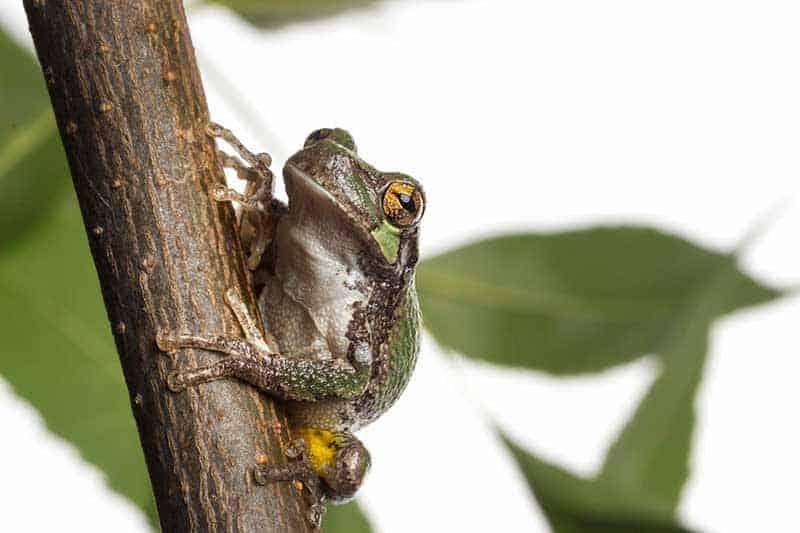Are there tree frogs in Wisconsin? You may be surprised that there are 7 species of tree frogs in the state. However, before exploring these types of tree frogs, it’s good to have an overview of exactly what a tree frog is.
By definition, tree frogs are species of frogs that spend the majority of their lifespan in arboreal states. However, not all tree frogs actually live in trees. What unites tree frogs as a family is their feet. In tree frogs, the terminal phalanx, which is the last bone in the toes of tree frogs, has the shape of a claw.
Most tree frogs primarily live in trees or other high-growing vegetation and descend to the ground to mate or spawn. When they’re mating and spawning, tree frogs will usually build foam nests on leaves and other ground vegetation. Once they reach adulthood, tree frogs rarely leave their arboreal habitat.
Tree Frogs in Wisconsin
Tree frogs are fast and elusive little creatures, leaping from one tree to another with an agility that is nearly mind-boggling. Because of how quickly they move, tree frogs in Wisconsin are difficult to spot. They also do a great job of camouflaging themselves.
According to the Wisconsin Department of Natural Resources, there are only 12 species of frogs in the state and over half of those are in the tree frog family.
The 7 species of tree frogs in Wisconsin are the gray tree frog, Cope’s Gray tree frog, Blanchard’s cricket frog, northern cricket frog, western chorus frog, boreal chorus frog, and the spring peeper.
All of the following species are in the Hylidae family of frogs.
1. Gray Tree Frog
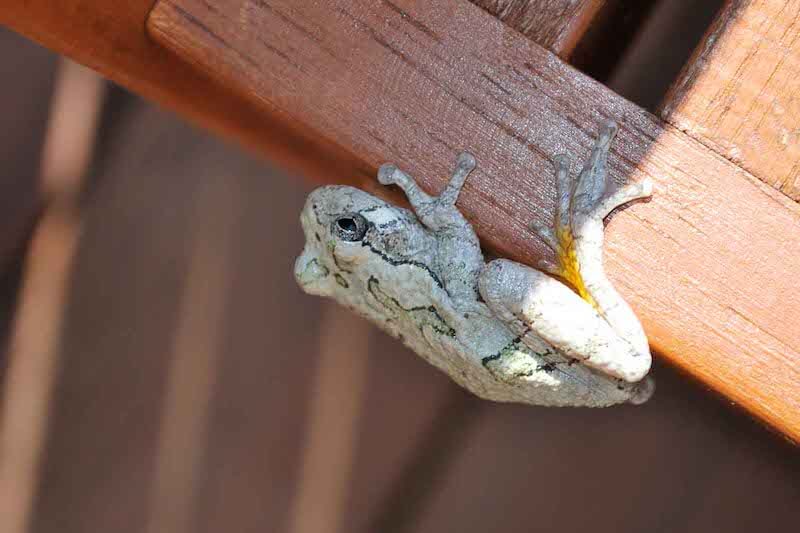
Scientific name: Hyla versicolor
Usually the larger of Wisconsin’s two tree frog species, the Gray tree frog is between 1.5 and 2.0 inches long (3.8-5.1 cm).
Gray tree frogs are chameleon-like and they change color or with substrate color or temperature. The background color of these frogs can vary between green to gray, and they have black-colored mottling. They don’t lose their mottling when it’s warm, but their color can become slightly faded.
All Gray tree frogs have a white spot underneath each eye. They also have inner thigh markings that are bright yellow.
In these frogs, the pronounced toe pads serve as suction cups that allow them to cling to a variety of different surfaces.
Many people have suggested that the call of the Gray tree frog is more melodic than that of the Cope’s Gray tree frog. These frogs call on warm, humid, or rainy days even when they’re not in the breeding season.
In terms of habitat, Gray tree frogs live in large woodlots and forests, and they breed in wetlands. Something interesting about these frogs is that they can survive freezing to as low as 18 degrees Fahrenheit.
Gray tree frogs can be found in the entire state of Wisconsin. They are also found in most of the eastern part of the U.S. and as far west as Oklahoma and central Texas. These frogs also range into the Canadian provinces of Ontario, Quebec, Manitoba, with a small population in New Brunswick.
2. Cope’s Gray Tree Frog
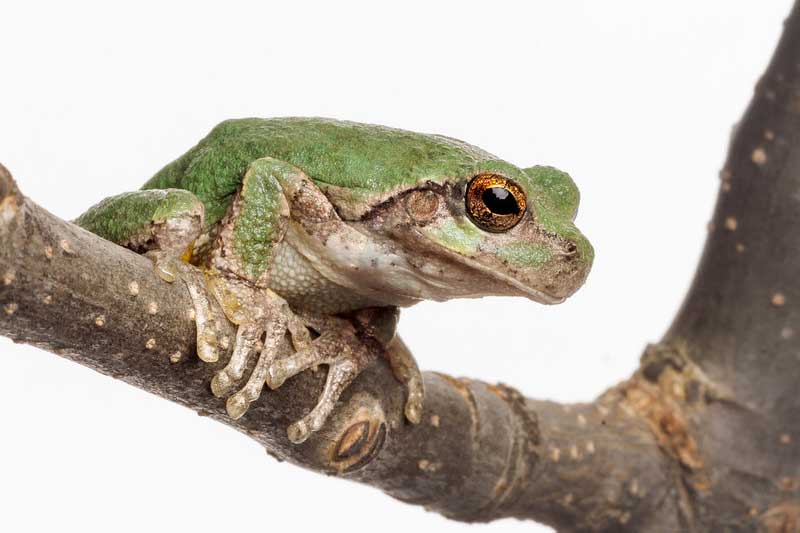
Scientific name: Hyla chrysoscelis
Cope’s Gray tree frogs tend to be just slightly smaller than the other Wisconsin tree frog species. These frogs are between 1.25 and 2.0 inches long (3.2-5.1 cm).
Unlike Gray tree frogs, the Cope’s Gray tree frog loses its mottling when it’s warm. Their skin is slightly smoother than that of the Gray tree frog but other than that, it’s difficult to distinguish between the two species.
During the breeding season, Cope’s Gray tree frogs are typically heavily mottled on the top side (dorsal), just like the Gray tree frog. However, these tree frogs are frequently a solid lime green color on the back when they’re not breeding.
Like the Gray tree frogs, the Cope’s Gray tree frogs have thigh markings that are bright yellow in color when viewed laterally or from the underside, particularly if the legs are extended.
The best way to distinguish the Cope’s Gray tree frog from the Gray tree frog is the difference in their calls during mating season. The Cope’s Gray tree frog has a call that is short and raspy.
These frogs live in oak savanna, woodlot edges, and in forests, where they favor brush over trees.
Cope’s Gray tree frogs can be found in the southern, western, and eastern areas of Wisconsin. Beyond Wisconsin, these frogs can be found throughout the southeastern parts of the U.S. except for the Florida peninsula. They are also found in nearly all of Georgia and South Carolina.
3. Blanchard’s cricket frog
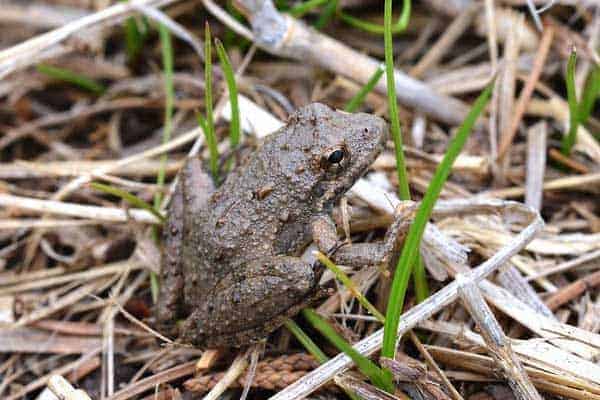
Scientific name: Acris blanchardi
The Blanchard’s cricket frog is another small tree frog of the family Hylidae, and are known as the most aquatic tree frogs in North America. They’re found in many midwestern U.S. states from Texas to Michigan, Southern Wisconsin, and Minnesota where they’re threatened or endangered.
They only reach about 1.5 inches in length as adults and are usually found near ponds, lakes, and slow moving bodies of water. Because of their mostly aquatic tendencies, they will always be close to water and are actually considered non-climbing tree frogs.
They are typically tan, brown, gray, or olive green in appearance. These frogs come out of hibernation each year in late March or early April. Like other small tree frogs in Wisconsin, they feed on small invertebrates like insects, arachnids, and snails.
4. Northern spring peeper
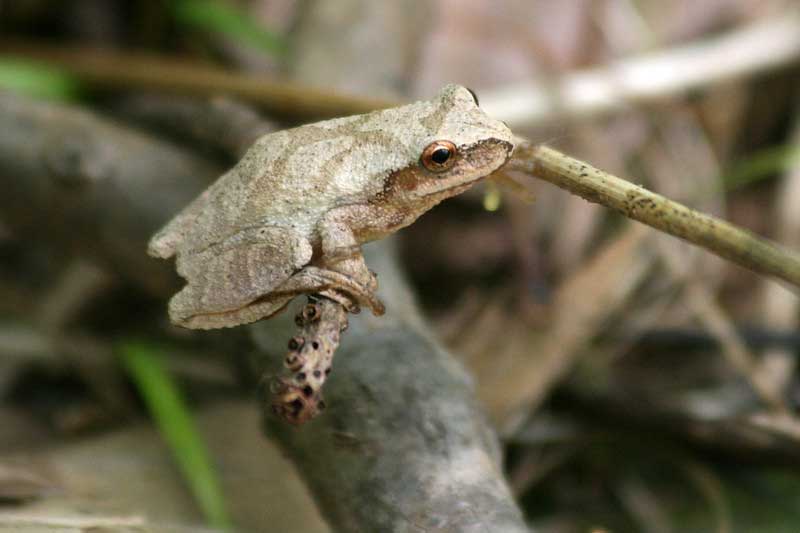
Scientific name: Pseudacris crucifer
The northern variety of the spring peeper, a representative of Wisconsin’s frogs, can be found throughout the eastern half of the United States. These tiny tree frogs only grow to about an inch in length as adults, but they make up for their size with their big voices.
Like other tree frogs and chorus frogs, it’s the males that are so loud with their mating calls. If you’re close to a male spring peeper, their sound can reach about 90 decibels, which is about as loud as a lawnmower. A rock concert is about 120 decibels for comparison. If you hear a chorus of spring peepers, even from a distance it’s still going to be in the 60-70 decibel range.
Adult spring peepers come out in the late afternoon and early evenings to feed on a variety of small insects and invertebrates. They begin breeding in the early spring and females will lay 750-1200 eggs submerged, attached to aquatic vegetation. The tadpoles will emerge in a week or two and turn into frogs within another 6-12 weeks.
5. Western chorus frog
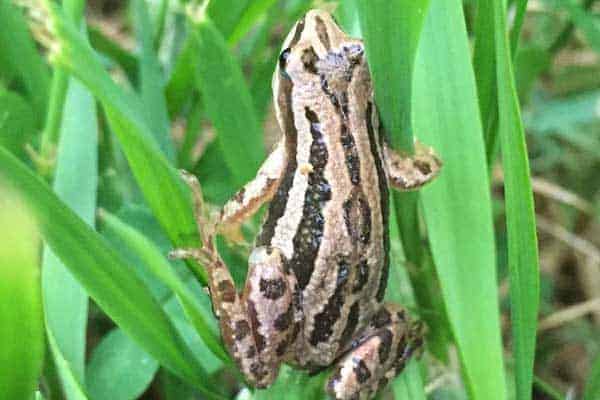
Scientific name: Pseudacris triseriata
The western chorus frog is a common tree frog in Wisconsin, more in southern parts of the state. They’re found throughout much of the midwest and eastern United States. South of Arkansas, Illinois, and Indiana, you’ll find the upland chorus frog.
Western chorus frogs are one of the smallest tree frogs in Wisconsin, and the country. As adults they are sometimes less than an inch in length. They prefer living near wooded areas, ponds, marshes, wetlands, or slow moving bodies of water.
The color varies and may be anywhere from greenish gray to brown. You can identify them by the 3 dark stripes going down their backs and their small size. They are very difficult to distinguish from boreal frog that’s up next. Though it’s believed that the western variety has longer legs.
6. Boreal chorus frog

Scientific name: Pseudacris triseriata maculata
The boreal chorus frog is a subspecies of the western chorus frog. They are rare in Wisconsin and only occur in the northern half of the state that enters their extreme southern range.
These frogs are brown, reddish, tan, gray or olive in color with 3 dark stripes along their backs. They’re about 1.5 inches in length as adults and their range does overlap with the western chorus frog in some places. The boreal variant is much more common in Canada than it’s cousin.
7. Northern Cricket Frog
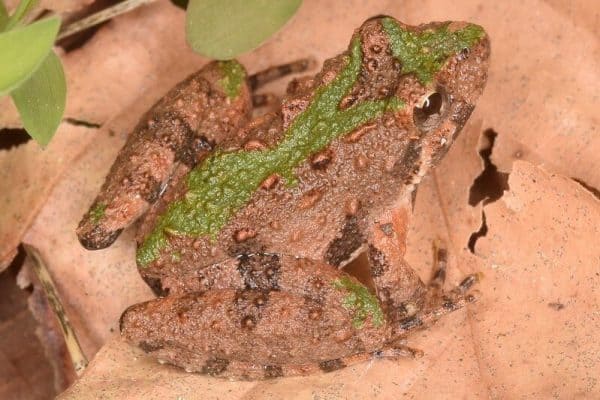
Scientific name: Acris crepitans
Northern cricket frogs have long back legs, a pointed snout and slightly warty skin. Their color can vary from green to brown and brownish red. They have a stripe (color varies) that extends between the tops of their eyes and a “Y” shaped stripe on their back. The northern variety has more webbing on their back toes and the dark stripe on their thigh has ragged edges.
Cricket frogs are active both day and night and like pond, marsh, stream and river habitats where they will live in the vegetation along the shore. They lay single or small groups of eggs, and the tadpoles have a black tip on their tail. Northern cricket frogs will call from April to August.
Northern cricket frogs are less common in Wisconsin than the Blanchard’s cricket frog and only occur in southern areas of the state.
FAQ About Tree Frogs in Wisconsin
Below are some frequently asked questions about Wisconsin tree frogs.
Are tree frogs in Wisconsin poisonous?
The Cope’s Gray tree frog produces a secretion from their skin that is toxic. This secretion can cause discomfort to the lips, eyes, open cuts, abrasions, and mucus lining of the nose in humans. Tree frogs are considered to be poisonous, but they are not venomous.
While not a tree frog, the American Toad, one of the poisonous frogs in Wisconsin, is found in the state. However, people can usually hold them with no problem.
What do Wisconsin tree frogs eat?
Tree frogs eat spiders, ants, mealworms, and other small insects.
Can you touch a tree frog?
These frogs are timid and for their protection, it’s best to not touch them. For example, if you have any oil, soap, or other chemicals on your hands, you can harm the frogs because their skin is extremely porous.
Moreover, frogs are animals that like to observe, and they don’t need to be held.
